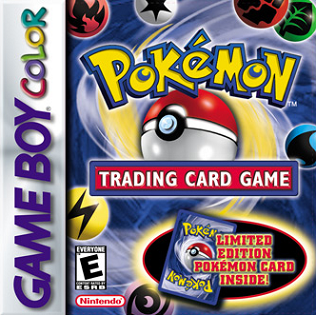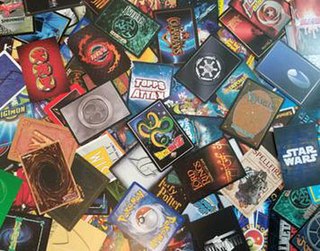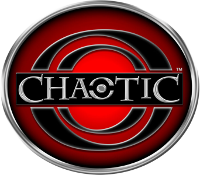
The Pokémon Trading Card Game, abbreviated as PTCG or Pokémon TCG, is a collectible card game developed by Creatures Inc. based on the Pokémon franchise. Standard gameplay cards include Pokémon cards, energy cards, trainer cards, and stadium cards, a variant of trainer cards. Pokémon cards contain data about the creature's type, attacks, ability, and HP as well as any special effects the cards have on the game. Basic (unevolved) Pokémon can change into their evolved forms during the game by playing subsequent evolution cards in the deck. Energy cards can be attached to Pokémon cards to power up attacks, and trainer cards can be used for different effects on the game. Card effects often rely on elements of luck, such as dice rolls and coin tosses, to decide an outcome. Counters are stacked on top of cards in play to indicate damage dealt, and players may choose to put their Pokémon cards on a bench to switch to a different attacker.

Pokémon Trading Card Game is a video game adaptation of the Pokémon tabletop card game for the Game Boy Color. Developed by Hudson Soft and Creatures and published by Nintendo, it was initially released in Japan on December 18, 1998, in Australia on April 7, 2000, in North America on April 10, 2000, and in Europe on December 15, 2000. The game includes the first three sets of the trading card game, as well as exclusive cards not available elsewhere.

The Yu-Gi-Oh! Trading Card Game is a collectible card game developed and published by Konami. It is based on the fictional game of Duel Monsters created by manga artist Kazuki Takahashi, which appears in portions of the manga franchise Yu-Gi-Oh! and is the central plot device throughout its various anime adaptations and spinoff series.

The Duel Masters Trading Card Game is a two-player or two vs. two team collectible card game (CCG) jointly developed by Wizards of the Coast and Takara Tomy. The card game is part of the Duel Masters franchise.

The 'Neopets TCG' is an out-of-print collectible card game and a spin-off of the popular virtual pet browser game, Neopets. The game was launched in 2003 and produced by Wizards of the Coast, a large trading card company that produces a variety of other trading card games. Neopets is aimed at a slightly younger audience than other Wizards of the Coast offerings such as Magic: The Gathering. As with many other trading card games, the cards serve two purposes, collecting and playing a game.

The Harry Potter Trading Card Game is an out-of-print collectible card game based in the world of J. K. Rowling's Harry Potter novels. Created by Wizards of the Coast in August 2001, the game was designed to compete with the Yu-Gi-Oh!, Pokémon and Magic: The Gathering card games. Its release was timed to coincide with the theatrical premiere of the first film in the series. The game was praised for the way it immersed children in the Harry Potter universe. At one point the game was the second best selling toy in the United States; however, it is now out of print.

The World of Warcraft Trading Card Game is an out-of-print collectible card game based on Blizzard Entertainment's MMORPG, World of Warcraft. The game was announced by Upper Deck Entertainment on August 18, 2005 and released on October 25, 2006. Players can play against each other one-on-one, or can join others in order to defeat dungeon/raid "bosses" based on those in the MMORPG. In March 2010, Upper Deck lost the license from Blizzard Entertainment. The license was acquired by Cryptozoic Entertainment later in the month, with the company announcing that planned card sets would be released.

Avatar: The Last Airbender Trading Card Game is an out-of-print collectible card game based on the Nickelodeon animated television series Avatar: The Last Airbender. Upper Deck Entertainment launched this title in the first quarter of 2006.

The Bleach Trading Card Game is an out-of-print collectible card game from Score Entertainment, and is based on the manga and anime series of the same name. The game received a nomination for Origin's "Game of the Year" and earned a semi-finalist position.

Chaotic is an out-of-print Danish collectible card game brought to the United States by Chaotic USA and 4Kids Entertainment, and distributed by TC Digital Games. It was released along with the open beta version of the online game on October 24, 2007. The card game is also featured in the animated series of the same name. As of 2014, the website is currently closed and the cards are no longer in production.
Chaotic is an American animated science fantasy television series produced by 4Kids Entertainment. It was animated by Canadian studio Bardel Entertainment for season 1 and South Korean studio Dong Woo Animation for season 2 and 3. It is based on the Danish trading card game of the same name, with most of the plot based on the original storyline of the Danish trading card game.
Before its current form, the Chaotic Trading Card Game had several names and versions. Starting in Denmark, Dracco Heads was a children's collectors product featuring plastic figurines of strange creatures. In 2000, a trading card game called Grolls & Gorks was published featuring characters and creatures from Dracco Heads. The next year, the game was redesigned by Bryan C. Gannon, and renamed Chaotic: Now or Never! This version of the card game had many characters and cards on which the current version of the Chaotic game and the television series are based.

A collectible card game (CCG), also called a trading card game (TCG) among other names, is a type of card game that mixes strategic deck building elements with features of trading cards. It was introduced with Magic: The Gathering in 1993.
A sideboard, side deck, or side is a set of cards in a collectible card game that are separate from a player's primary deck. It is used to customize a match strategy against an opponent by enabling a player to change the composition of the playing deck.

Pokémon TCG Online was a 2011 video game based on the Pokémon Trading Card Game developed by Dire Wolf Digital, a studio based in Denver, Colorado. The game was available for Microsoft Windows, macOS, iOS and Android. It was originally released in March 2011 under the name of Pokémon Trainer Challenge as a browser-based game.

The Elder Scrolls: Legends is a free-to-play digital collectible card video game, published by Bethesda Softworks for Microsoft Windows, iOS, macOS and Android in 2017.

The Final Fantasy Trading Card Game, often abbreviated as Final Fantasy TCG or FF-TCG, is a trading card game developed by Hobby Japan and published by Square Enix. The first iteration was released in Japan in 2011 but never released outside Japan and was discontinued in order to release a second iteration worldwide in October 2016.

SpongeBob SquarePants Trading Card Game is an out-of-print collectible card game by Upper Deck based on the cartoon series of the same name. The game was first released in 2003.














